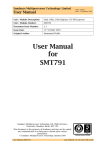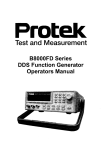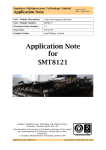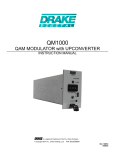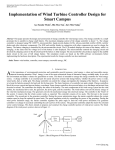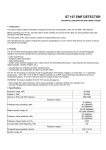Download SMT391 User Manual
Transcript
SMT391 User Manual Version 1.5 Page 2 of 18 SMT391 User Manual Revision History Date Comments Engineer Version 25/04/05 First release JPA 1.0 15/07/05 Added information about on-board clocks. JPA 1.1 31/08/05 Updated performances. JPA 1.2 14/06/06 Errata: external trigger maximum frequency. JPA 1.3 21/09/06 Added: weight characteristic SM 1.4 28/09/06 Removed: DC-coupled version not supported SM 1.5 Version 1.5 Page 3 of 18 SMT391 User Manual Table of Contents Revision History.......................................................................................................... 2 Table of Contents ....................................................................................................... 3 Introduction................................................................................................................. 4 Overview ................................................................................................................. 4 Module Features ..................................................................................................... 4 Possible Applications .............................................................................................. 4 Related Documents ................................................................................................ 5 Hardware overview..................................................................................................... 6 Block diagram ......................................................................................................... 6 ADC AT84AD001B ................................................................................................. 6 Main analogue features........................................................................................... 6 Inputs / outputs ....................................................................................................... 7 Clock structure ........................................................................................................ 8 Description of the Clock Tree .............................................................................. 9 SLB ......................................................................................................................... 9 Performances ........................................................................................................... 10 Introduction ........................................................................................................... 10 VCO Clock ............................................................................................................ 10 Components location................................................................................................ 12 Physical Properties................................................................................................... 14 Power Supply........................................................................................................ 14 Module Dimensions .............................................................................................. 15 Appendixes............................................................................................................... 16 SMT391 PCB View ............................................................................................... 16 SMT391 Assembly Drawings ................................................................................ 17 Test points location ............................................................................................... 18 Version 1.5 Page 4 of 18 SMT391 User Manual Introduction Overview The SMT391 is a single width TIM module. It is capable of sampling two analogue inputs at 1 GSPS with a resolution of 8 bits. An Atmel dual channel ADC (AT84AD001) performs the analogue to digital conversion. The SMT391 is a “Daughter-Module” that combines with a “base module” such as the SMT338-VP. Thanks to this configuration, all the analogue circuits are on the SMT391 (on the top) and the digital circuits are on the base module (on the bottom). This allows reducing the cross-talk, provide better separation and heat-dissipation. The interface between the base module and the SMT391 is digital. It is implemented using the Sundance LVDS Bus (SLB). Module Features The main features of the SMT391 are listed underneath: • Dual channel ADC (Ideal for I & Q channel applications) • 1GHz sampling frequency • 8 Bit data resolution • Custom Clock and Trigger inputs via external connectors • SLB connector to interface to the wide range of Sundance base modules Possible Applications The SMT391 can be used for the following applications (this non-exhaustive list should be taken as an example): • Broadband cable modem head-end systems • 3G Radio transceivers • High-data-rate point-to-point radios • Medical imaging systems • Spectrum analyzers Version 1.5 Page 5 of 18 SMT391 User Manual Related Documents [1] Sundance LVDS Bus (SLB) specifications – Sundance. http://www.sundance.com/docs/SLB%20-%20Technical%20Specifications.pdf [2] Dual 8-bit ADC datasheet - Atmel. http://www.atmel.com/dyn/resources/prod_documents/doc2153.pdf Hardware overview Block diagram The following diagram represents the architecture of the SMT391 daughter module. Base module SLB connector Control AT84AD0001B Dual 8-bits 1 Gsps ADC Control Low jitter local oscillator Clock generation and distribution External clock Signal conditionning Signal conditionning Channel I Channel Q ADC AT84AD001B Main analogue features The main analogue characteristics of the SMT391 are listed in the following table: Analogue inputs Input voltage range 0.5Vp-p Impedance 50Ω - terminated to ground Analogue Bandwidth ADC Bandwidth: 1500MHz RF Transformer: 500kHz to 1.5GHz (AC Coupled) External sampling clock inputs Signal format LVPECL Frequency range Up to 1000 MHz Version 1.5 Page 7 of 18 SMT391 User Manual External trigger inputs Signal format LVPECL Frequency range Up to 25 MHz SMT391 Output Output Data Width 8-Bits Data Format Binary ADC Performance @ FS = 1 GSPS, FIN = 500 MHz (from Atmel datasheet) Spurious Free Dynamic Range (SFDR) -54dBc Signal to Noise and Distortion (SINAD) 45dB Effective Number Of Bits (ENOB) 6.8 Bits Total Harmonic Distortion (THD) -51dB Cross-talk channel I versus channel Q (Cr) FIN = 250 MHz, FS = 1 GHz < -65dBc Figure 1 - Main features. Inputs / outputs The SMT391 is an AC-coupled mode. The AC-coupled option uses a twisted pair balun (MACOM TP-101) transformer to convert a single ended signal to a balanced AC Coupled input on the ADC. The figure on the following page shows this setup. Note that the input on the ADC is differential and that for each of these two signals there are two pads on the ADC. One pad connects to the transformer and the second pad is terminated through a 50 Ohm resistor to ground. R1 TP101 Input Connector R1 Version 1.5 Page 8 of 18 SMT391 User Manual Figure 2 – AC-coupled Analogue Input stage. Clock structure There is an integrated clock generator (PLL+VCO clock or synthesized clock) on the module. The user can either use this clock or provide the module with an external clock (input via MMBX connectors, one for each channel). External Clock Module Clock External Clock Input (MMBX) PLL Voltage Controlled Oscillator Comparitor LVPECL Buffers TTL to LVPECL 4:2 Mux with Dual Output Clock Div 8 Ch B Clock Ch A Clock ADC LVDS SerDes Clock RSL Clock DLL Sys Clock DLL FPGA Diagram Key: 500 MHz LVDS Clock 125 MHz LVPECL Clock 1000 MHz LVPECL Clock Clock Control Version 1.5 Page 9 of 18 SMT391 User Manual Figure 3 – Module Clock Structure. Description of the Clock Tree The main clock source of the module is a UMC 600MHz to 1200MHz voltage controlled oscillator. The frequency range of the VCO is adjustable with a National PLL. The output of the VCO + PLL combination is passed through a Maxim high frequency comparator with an LVPECL output to form the main system clock. In addition to this clock there is a clock synthesizer on the module that can generate a 50 to 950 MHz clock. This clock is ideal for testing purposes. Alternatively the user can provide the module with an external LVPECL clock – one input for each channel. The clock synthesiser does not provide a clock as clear as the VCO does. Therefore the performances of the module degrade when using the clock synthesiser. The FPGA controls the LVPECL multiplexers that choose the final clock (clock synthesizer, PLL+VCO, or external). A copy of this clock is fed to each channel of the ADC. Another copy is divided by 8 (to give a 125MHz LVPECL clock) and fed into the FPGA. (In the current firmware implementation this copy of the clock is not used by the firmware design. The two clocks originating from the ADC is used by the design. This clock can also only be the VCO or the synthesizer clock, not one of the external clocks.) The ADC clock determines the sampling rate of the ADC. The ADC buffers and divides this clock by two (or four) to provide a 500MHz LVDS clock for each demultiplexed data channel (or a 250MHz DDR clock depending on the way the ADC is configured). These two clocks are used to clock the ADC data into the FPGA. When data is transmitted over the RSL links there must be a reference clock on the receiving module that is closely matched in frequency to the transmitting clock. This is important to insure that there will be no data over or under run. Due to this requirement data can only be transmitted over the RSL interface when the on-board VCO clock is used. All clock circuitry is implemented on the daughter card. The four clocks that enter the FPGA are passed down from the daughter card to the main module. An additional 125MHz oscillator is located on the main module. This oscillator is used as the system clock for the FPGA design. SLB The SMT391 connects to a base module (for example a SMT338-VP) via the SLB connector. Refer to the SLB specification document for more information. Version 1.5 Page 10 of 18 SMT391 User Manual Performances Introduction The following figures show data captures using the SMT391-VP to capture the data and MATLAB to plot and display it. As the SMT391-VP is a broadband converter no type of band-pass filtering were used when capturing these results. FFT Spurs might thus seem high at certain points, but in a specific system application selective signal filtering will significantly increase the quality of the captured signal. The analogue input signal used is also not derived from the same clock source as the sampling clock. There is thus also no frequency coherence, which will once again add additional spurs to the FFT. VCO Clock The following figures show captures of the performance of the SMT391 onboard VCO clock. This data was measured at the point where this clock is distributed to the FPGA. The 1000MHz clock is split, one side goes to the ADC, and the other side is divided by 8 (giving a 125MHz clock) and then passed on to the FPGA. Figure 4 – FFT of Div 8 Version of 1000MHz System Clock. Version 1.5 Page 11 of 18 SMT391 User Manual Figure 5 – Time View of Div 8 Version of 1000MHz System Clock. Figure 6 – Measured Results of the Clock. Version 1.5 Page 12 of 18 SMT391 User Manual Components location The following diagram indicates the location of all the important connectors and components on the SMT391 (Rev 2) PCB. This specific diagram is for an AC-coupled analogue input stage using a Macom transformer. Figure 7 – Connector Location on SMT391 (Rev 2 PCB, AC Coupled). Diagram Ref Pcb RefDes Description Notes A J9 External Trigger I Channel LVPECL Signal. Positive on inside of connector. Negative on outside of connector. E J10 External Trigger Q Channel LVPECL Signal. Positive on inside of connector. Negative on outside of connector. B J3 External Clock I Channel LVPECL Signal. Positive on inside of connector. Negative on outside of connector. F J4 External Clock Q Channel LVPECL Signal. Positive on inside of connector. Negative on outside of connector. C J1 ADC I Channel Input Analogue signal input for ADC Channel I. Signal on inside of connector. Analogue ground on outside of connector. G J2 ADC Q Channel Input Analogue signal input for ADC Channel Q. Signal on inside of connector. Analogue ground on outside of connector. D J8 Analog Test Signal Analogue output test signal. Variable between 200 and 350MHz. Signal on inside of connector, Analogue ground on outside of connector. Use a 1:1 RF cable to connect J8 to either J1 or J2 for easy verification of the working of the ADC. Figure 8 – Table of Connector Locations on SMT391. Version 1.5 Diagram Ref Page 13 of 18 Pcb RefDes Description SMT391 User Manual Notes H JP2 FPGA JTAG Connector FPGA on SMT338-VP JTAG Chain. Only routed down to SMT338-VP. Use for easy access without having to remove the SMT391. K JP1 MSP JTAG Connector MSP430 on SMT338-VP JTAG Chain. Only routed down to SMT338-VP. Use for easy access without having to remove the SMT391. L U1 Atmel Dual ADC ADC Requires heat-sink with air-flow cooling in a system setup I VCO1 UMC 600 – 1000MHz VCO Main Clock source for SMT391. VCO Requires heat-sink with air-flow cooling in a system setup. I VCO2 UMC 200 – 350MHz VCO Test Clock for testing the analogue input of the ADC. VCO Requires heat-sink with air-flow cooling in a system setup. J TRANS1 M/A Com TP101 Transformer The SMT391 analogue input is AC-coupled through a twisted pair balum transformer (single ended to differential). J TRANS2 M/A Com TP101 Transformer The SMT391 analogue input is AC coupled through a twisted pair balum transformer (single ended to differential). Figure 9 – Table of Component Locations on SMT391. Version 1.5 Page 14 of 18 SMT391 User Manual Physical Properties Dimensions Weight 40 g. Supply Voltages Supply Current +12V +5V +3.3V -5V -12V MTBF Power Supply The following voltages are required by the SMT391 and must be supplied over the daughter card power connector. Voltage D+3V3_IN Current Required 2.0 A D+5V0_IN 500 mA D+12V0_IN 250 mA D-12V0_IN 250 mA DGND Figure 10 – SMT391 Power Supply Voltages. The following voltages are required by the SMT391-VP and must be supplied over the TIM connectors and TIM mounting hole Voltage D+3V3_IN Current Required 4.0 – 6.0 A D+5V0_IN 4.0 A D+12V0_IN 500 mA D-12V0_IN 500 mA DGND Figure 11 – SMT391-VP Power Supply Voltages. Version 1.5 Page 15 of 18 SMT391 User Manual The following table lists the internal SMT391 voltages that are derived from the voltages that are provided over the daughter card power connector. Voltage D+3V3 D+2V25 A+3V3 VCO+5V0 VCO+12V0 ECL-5V2 AGND Description Derived from D+3V3_IN Derived from D+3V3 on SMT391 Derived from D+3V3_IN Derived from D+5V0_IN Derived from D+12V0_IN Derived from D-12V0_IN Derived from DGND Figure 12 – Internal Power Supply Voltages. Module Dimensions The following table lists the dimensions for the SMT391 and the SMT391-VP. Description Module Dimensions (Only SMT391) Module Dimensions (SMT391-VP) Weight Value Width: 63.5 mm Length: 106.68 mm Height: 21mm (Maximum) Width: 63.5 mm Length: 106.68 mm Height: 21mm (Maximum) TBD Grams (including heat sinks) Figure 13 – SMT391-VP Dimensions. Version 1.5 Page 16 of 18 Appendixes SMT391 PCB View The following figures show the top and bottom view of the SMT391. Figure 14 – SMT391 Top View. SMT391 User Manual Version 1.5 Page 17 of 18 SMT391 User Manual Figure 15 – SMT391 Bottom View. SMT391 Assembly Drawings The following figures show the top and bottom assembly drawings of the SMT391. Figure 16 – SMT391 Top Assembly Drawing. Version 1.5 Page 18 of 18 SMT391 User Manual Figure 17 – SMT391 Bottom Assembly Drawing. Test points location The following figure shows the location of the voltage test points on the SMT391. Figure 18 – Voltage Test Point Locations.



















